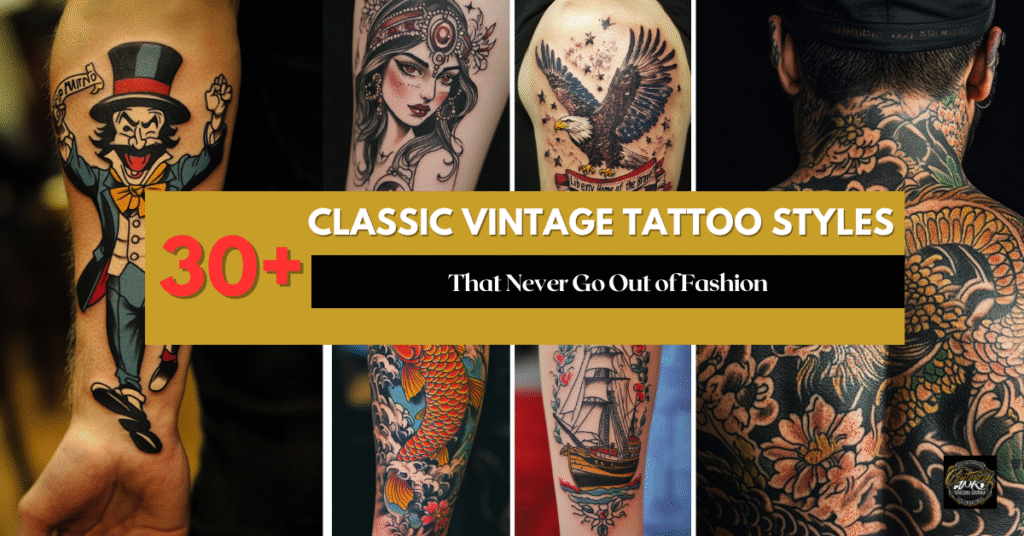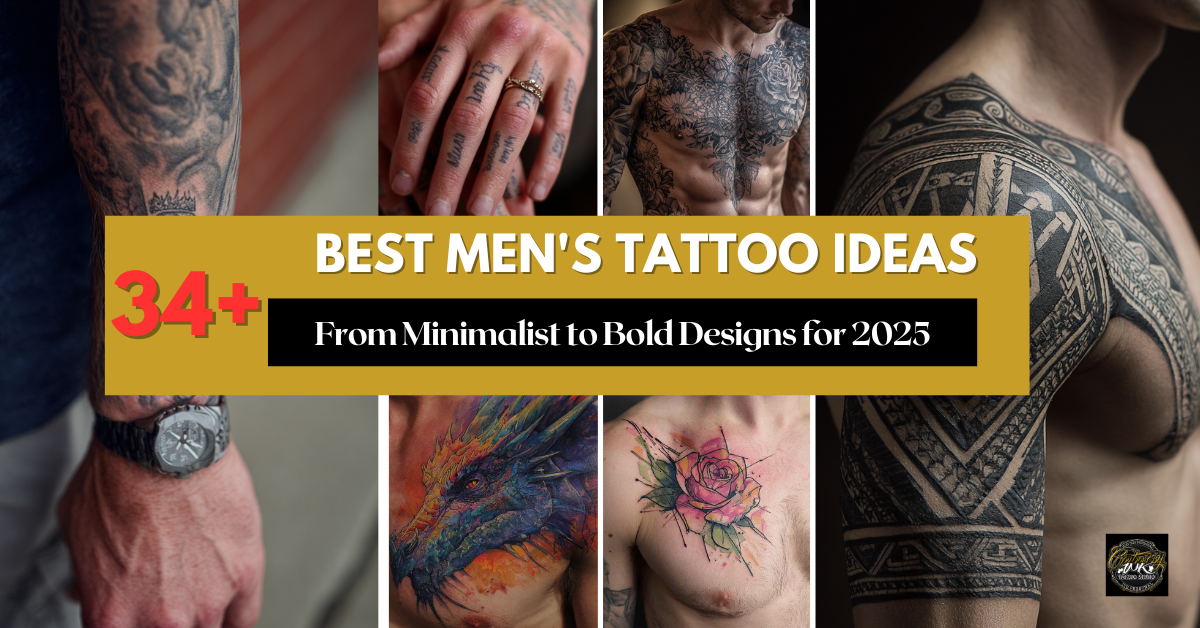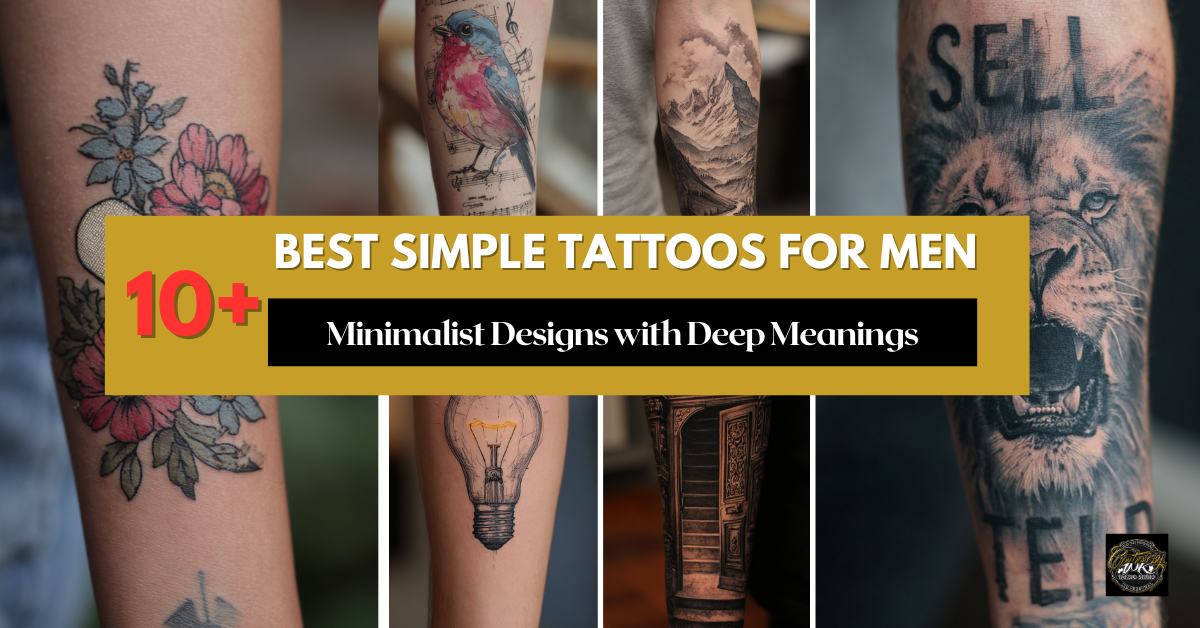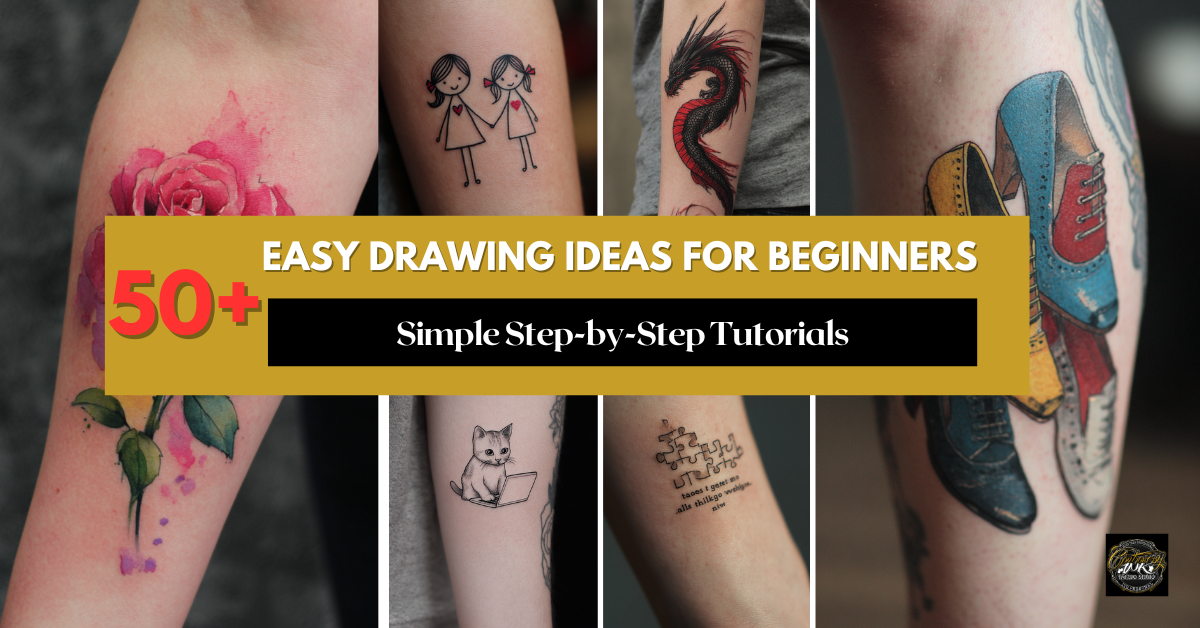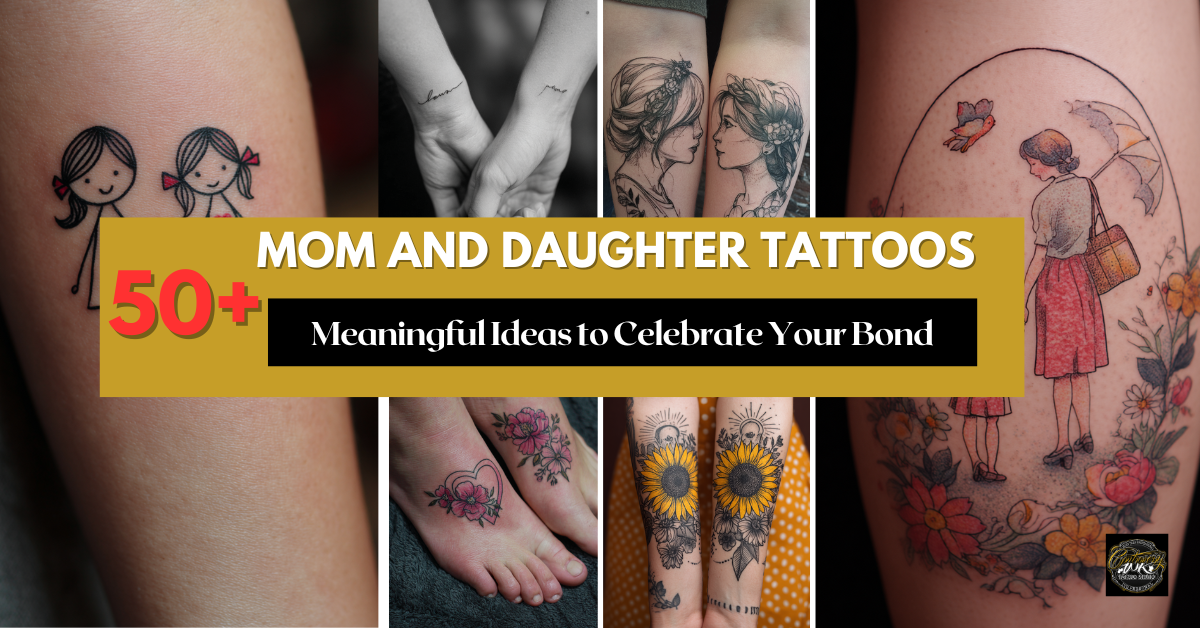Ever wondered why those classic anchor, rose, and eagle tattoos never seem to go out of style? Vintage tattoos aren’t just ink on skin—they’re pieces of living history that have adorned sailors, rebels, and free spirits for generations. From Sailor Jerry’s bold lines to traditional American designs that have withstood the test of time, these iconic images carry stories that modern designs simply can’t replicate.
You’ll find there’s something undeniably appealing about choosing a design that has adorned human skin for decades, even centuries. Whether you’re considering your first tattoo or adding to your collection, vintage-inspired pieces offer both timeless appeal and rich symbolism. These classic designs don’t just look good—they connect you to a long lineage of tattoo enthusiasts who came before you.
The Rich History of Vintage Tattoos Through the Ages
Ancient Beginnings of Tattoo Art
Tattoos date back over 5,000 years to ancient civilizations across the globe. Egyptian mummies bearing tattoo markings have been discovered from as early as 3000 BCE, with designs primarily found on female bodies, suggesting ritualistic or therapeutic purposes. In Polynesian cultures, elaborate tribal tattoos called “tatau” (where the word “tattoo” originates) represented social status, spiritual devotion, and personal identity. Meanwhile, the indigenous Ainu people of Japan practiced facial tattooing for women as a rite of passage, marking their transition into adulthood with distinctive patterns around the mouth.
Sailors and Maritime Tradition
Sailors in the 18th and 19th centuries revolutionized Western tattooing after witnessing indigenous practices during their voyages. Captain James Cook’s expeditions to Polynesia in the 1770s introduced the art form to European society, with sailors adopting protective symbols like anchors (representing stability), swallows (signifying sailing experience), and nautical stars (for navigation). These maritime designs weren’t just decorative—they served practical purposes too. Sailors tattooed their initials to ensure proper identification if they died at sea, while exact imagery indicated their sailing achievements and superstitions against the dangers of ocean travel.
The Carnival and Sideshow Era
Between 1890 and 1920, tattooed performers became major attractions in American and European carnival circuits. Fully tattooed individuals like Betty Broadbent and Artoria Gibbons achieved celebrity status, appearing in traveling circus shows where audiences paid to see their elaborate body art. This period coincided with the rise of professional tattoo artists like Sailor Jerry Collins, who began standardizing designs into what we now recognize as “flash sheets”—collections of pre-drawn tattoo designs displayed on parlor walls. These sheets established the iconic American traditional style characterized by bold outlines, limited color palettes, and simplified imagery that remains influential today.
Military Influence and Patriotic Symbolism
Industry Wars I and II dramatically expanded tattoo culture as millions of service members embraced the tradition. Military tattoos fulfilled multiple purposes: commemorating fallen comrades, displaying patriotism through eagle and flag designs, and preserving connections to loved ones with “mom” banners and pinup girls. Tattoo parlors near military bases flourished during this era, with artists like Sailor Jerry developing faster techniques to accommodate high demand from soldiers and sailors on leave. These wartime designs emphasized bold imagery that could be completed quickly while maintaining vibrant appearance over time—qualities that continue to define vintage tattoo aesthetics.
Mid-Century Rebellion and Biker Culture
The post-war period of the 1950s and 1960s transformed tattoos from military tradition to symbols of counterculture rebellion. Motorcycle clubs and outlaw bikers adopted tattoos as membership badges and expressions of anti-establishment values. Designs like skulls, daggers, and devils became popular, along with the iconic “Born to Lose” and “Death Before Dishonor” slogans. Influential artists like Philadelphia Eddie Funk and Lyle Tuttle brought innovative techniques to these classic designs, elevating the artistry while maintaining the bold, graphic style. The stigma associated with tattoos during this period only strengthened their appeal among those seeking to distance themselves from mainstream society.
Revival and Contemporary Appreciation
Vintage tattoo styles experienced a important revival beginning in the 1990s, spearheaded by artists like Ed Hardy who bridged the gap between traditional tattooing and fine art. This renaissance coincided with broader cultural acceptance of tattoos and growing appreciation for their historical significance. Today’s vintage-inspired tattoos honor traditional techniques while incorporating contemporary elements. Many modern artists specialize exclusively in American traditional, Japanese traditional, or other historical styles, preserving the distinct characteristics that have endured for generations. Vintage designs continue to attract tattoo enthusiasts for their proven longevity, bold appearance, and connection to tattooing’s rich cultural heritage.
Traditional Sailor Jerry Designs: Nautical Themes and Maritime Heritage
Anchors, Ships, and Swallows: Symbols of a Sailor’s Journey

Anchors represent stability and a safe return home in traditional sailor tattoos. These iconic symbols were often inked after crossing the Atlantic or serving 5,000 nautical miles at sea. Ships symbolize adventure and the sailor’s livelihood, typically portrayed with full sails to represent smooth voyages. Many sailors chose exact vessels they served on, creating personalized maritime mementos.
Swallows hold special significance in sailing culture, indicating a sailor’s experience of 5,000 nautical miles traveled. You’ll often see these birds paired in traditional designs, representing the hope of returning home safely. Sailors believed swallows would carry their souls to heaven if they perished at sea. Historical records show swallow tattoos dating back to British naval logs from the 1800s, making them one of the most authentic vintage maritime designs.
Nautical stars served as practical navigational symbols, representing the North Star that guided sailors home. These five-pointed stars remain popular modern adaptations that honor the practical seafaring origins. Sailors also favored rope designs encircling wrists or ankles, symbolizing a sailor’s skill and intimate knowledge of vital knots needed for survival at sea.
The Bold Color Palette of Traditional Maritime Tattoos

Traditional Sailor Jerry tattoos feature a distinctive limited color palette that’s instantly recognizable. The bold combinations primarily use red, yellow, blue, green, and black – colors that remain vibrant even as they age. Norman Collins (Sailor Jerry) developed specialized pigments that maintained their integrity even though sun exposure and weathering at sea.
Thick black outlines define these maritime tattoos, creating the signature bold look that ensures designs remain legible even as they age. This practical approach originated from necessity – sailors needed tattoos that would remain clear even though harsh conditions at sea and years of sun exposure. The high-contrast style features minimal shading, allowing the vibrant primary colors to dominate the design.
Red ink traditionally symbolizes blood and passion in sailor tattoos, used prominently in hearts, roses, and patriotic elements. Blue represents the ocean and loyalty, typically seen in water elements, swallow feathers, and nautical stars. Yellow adds contrast and vitality, particularly in traditional sunsets, ship lanterns, and candles. These historical color choices weren’t just aesthetic – they reflected the limited pigment options available to early maritime tattoo artists working on ships or in ports across the globe.
Old School Pin-Up Girls: Celebrating Feminine Beauty in Ink
The Influence of Alberto Vargas and Gil Elvgren
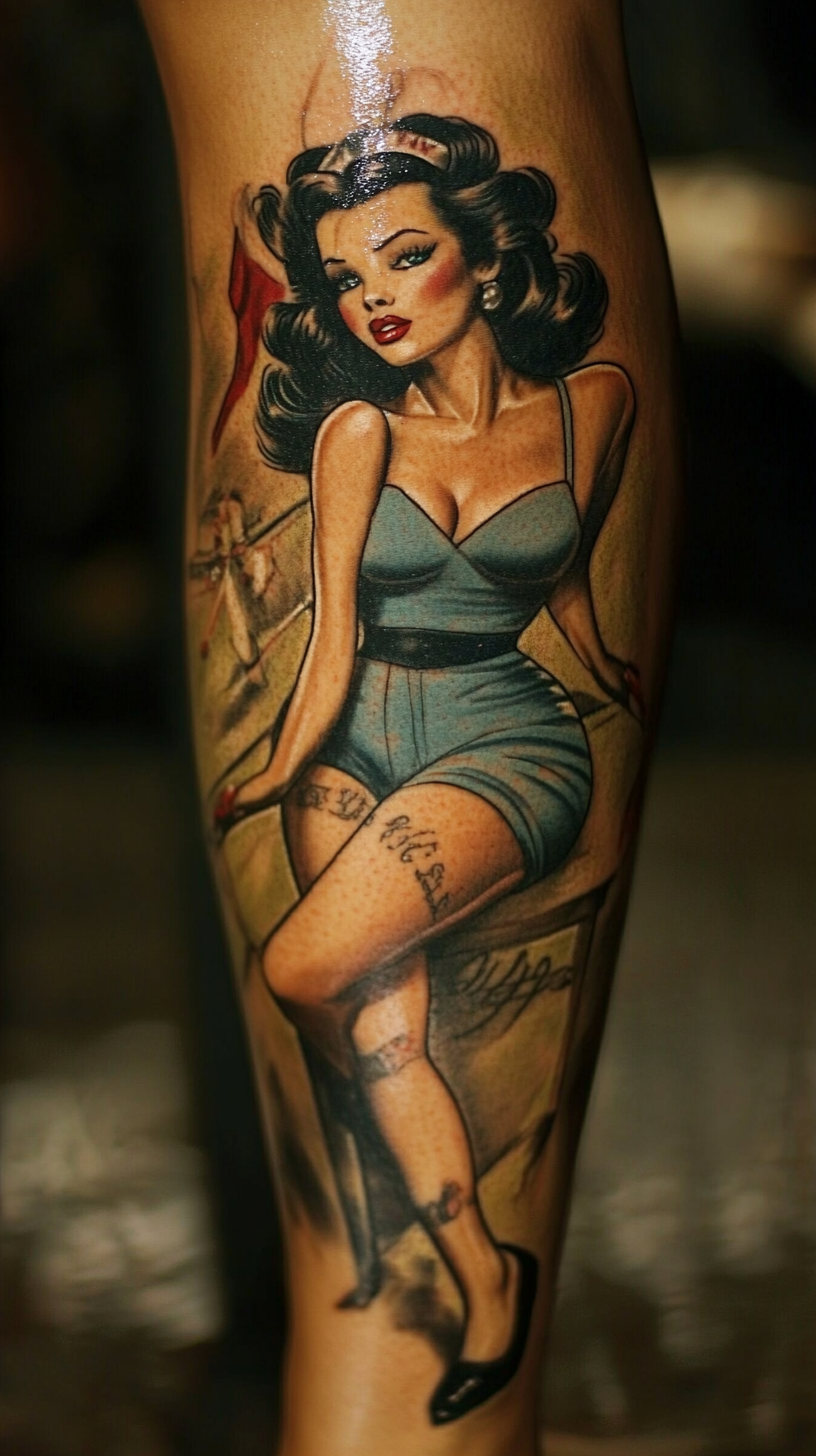
Pin-up girl tattoos draw important inspiration from two legendary artists of the mid-20th century: Alberto Vargas and Gil Elvgren. These iconic illustrators defined the pin-up aesthetic that tattoo artists still reference today. Vargas, known for his work in Esquire and Playboy magazines, created elegant, elongated figures with a distinctly sophisticated allure. His “Varga Girls” featured impossibly long legs, tiny waists, and perfectly coiffed hair that epitomized glamour during the 1940s and 50s.
Gil Elvgren, meanwhile, brought a more playful, girl-next-door quality to his pin-ups. His paintings often depicted everyday scenarios with a flirtatious twist—a skirt caught in the wind, a damsel in minor distress, or a woman caught in a charmingly compromising position. Elvgren’s characteristic use of rosy cheeks, bright red lips, and innocent expressions created the perfect balance of wholesome and sensual that translates beautifully to skin.
Tattoo artists specializing in vintage styles often study these masters’ color palettes, compositions, and character expressions. The distinctive poses—arched backs, coy glances over shoulders, and playful winks—have become standard elements in traditional pin-up tattoo designs. Many collectors choose these timeless beauties as larger statement pieces on thighs, backs, or upper arms, where the curves of the body complement the feminine forms.
Modern Interpretations of Vintage Pin-Up Tattoos
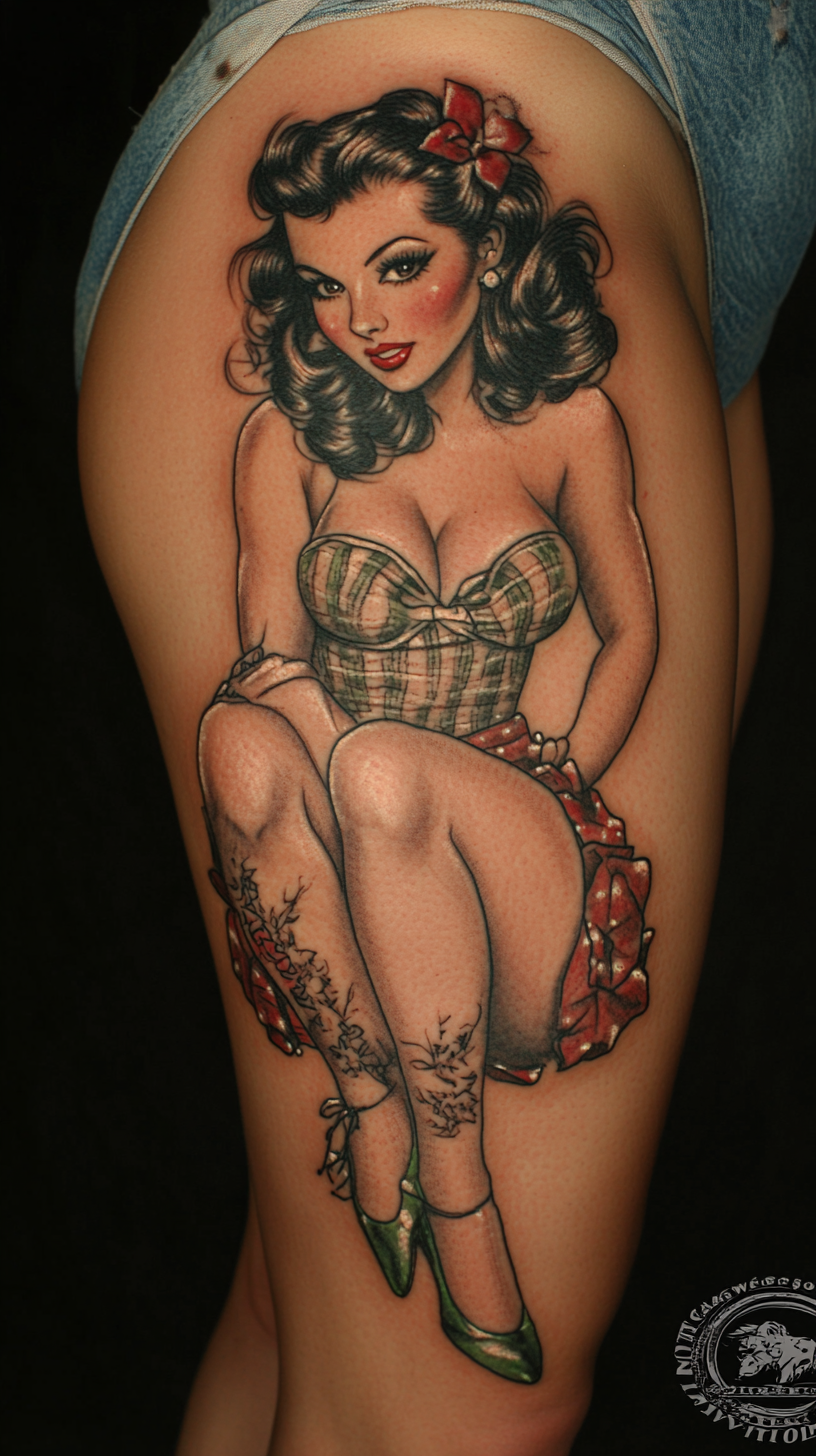
Today’s pin-up tattoos maintain the classic aesthetics while embracing modern diversity and personalization. Contemporary artists frequently customize traditional pin-up designs to reflect their clients’ identities, interests, and body types. You’ll find pin-up girls with varying skin tones, body shapes, and hairstyles that weren’t represented in the original mid-century illustrations.
Many tattoo enthusiasts now opt for pin-ups that incorporate personal elements—a favorite hobby, profession, or passion. A roller derby pin-up, a baker with a rolling pin, or a tattooed pin-up girl (meta!) all offer fresh spins on the classic concept. Some artists create zombie or Day of the Dead-inspired pin-ups, merging vintage glamour with horror themes for a distinctive contrast.
Neo-traditional techniques have also revolutionized the pin-up tattoo, introducing broader color palettes and slightly more stylized approaches while maintaining the bold outlines and solid colors characteristic of old-school tattoos. These modern pin-ups often feature more ever-changing poses and expressions than their predecessors, with artists pushing the boundaries of what defines the pin-up aesthetic.
Even though these contemporary adaptations, the essence of pin-up tattoos remains consistent—celebrating feminine beauty with a wink and a nod to vintage Americana. Whether rendered in traditional Sailor Jerry style or with modern twists, pin-up girl tattoos continue to rank among the most requested vintage-inspired designs, proving their timeless appeal across generations of tattoo enthusiasts.
Classic Americana: Eagles, Flags, and Patriotic Vintage Tattoos
The Symbolism Behind Patriotic Vintage Designs
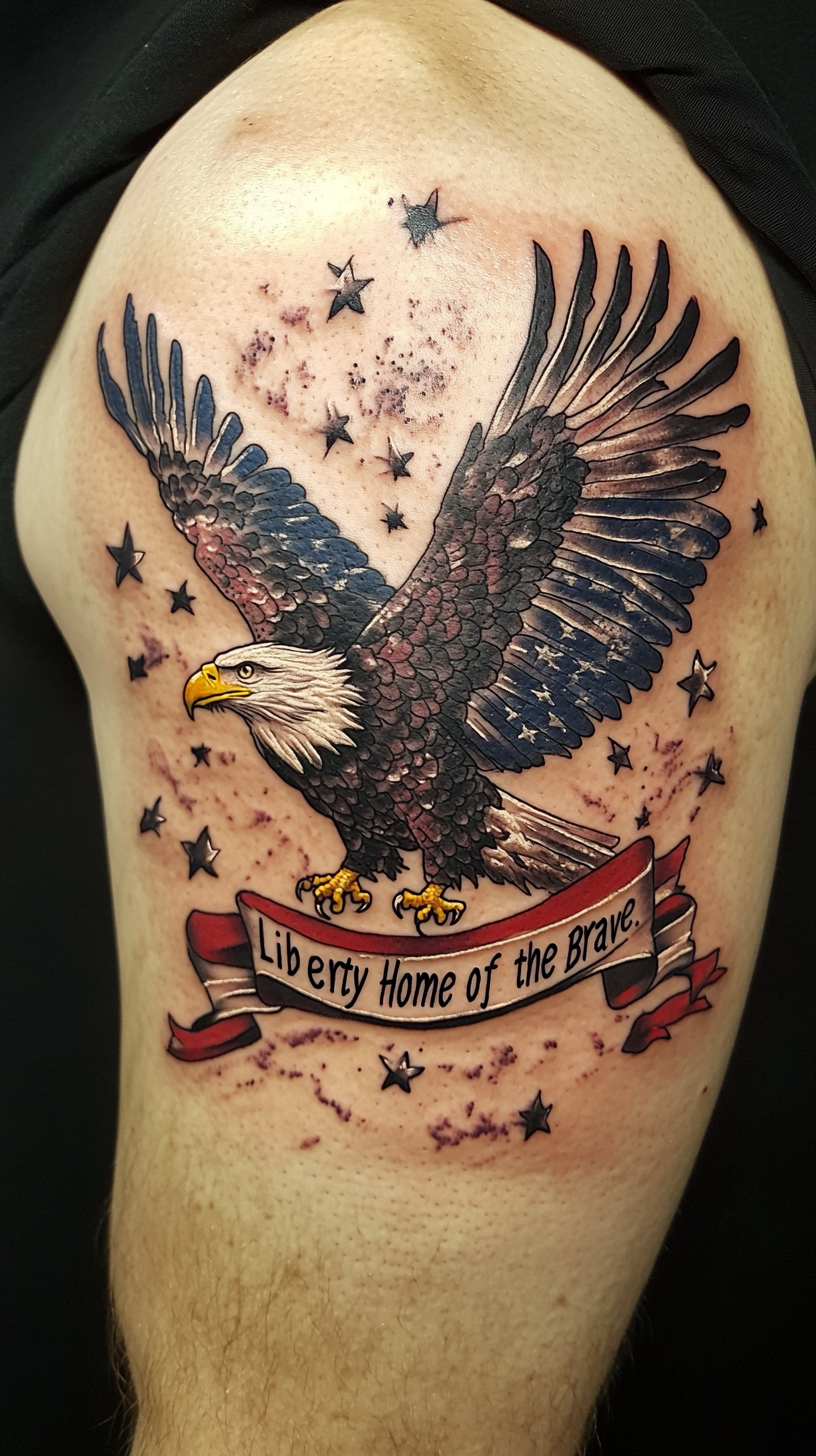
Patriotic vintage tattoos carry powerful symbolism that resonates with Americans across generations. These iconic designs aren’t just decorative—they’re meaningful statements about identity, values, and national pride.
- American Eagle Tattoos represent freedom, courage, and strength. These majestic birds often appear with wings spread wide, symbolizing protection and the soaring American spirit. Eagles paired with banners frequently include phrases like “Liberty” or “Home of the Brave.”
- American Flag Tattoos stand for loyalty, freedom, and national pride. Traditional renderings show the flag waving or draped, with bold red stripes and vibrant blue fields. These designs date back to WWII when service members proudly displayed their patriotism through ink.
- Lady Liberty Tattoos symbolize democracy, freedom, and enlightenment. Vintage interpretations often focus on her crown and torch, rendered in the bold lines and limited color palette characteristic of traditional American tattooing.
- Uncle Sam Tattoos represent civic duty and American identity. The classic “I Want You” pointing figure makes for a striking vintage design, typically executed with red, white, and blue highlights against bold black outlines.
- Stars and Stripes Motifs offer versatile patriotic symbolism that can be incorporated into larger pieces or stand alone. Traditional American tattoo artists like Sailor Jerry frequently used these elements to frame other designs or create borders.
How War Eras Shaped American Tattoo Culture
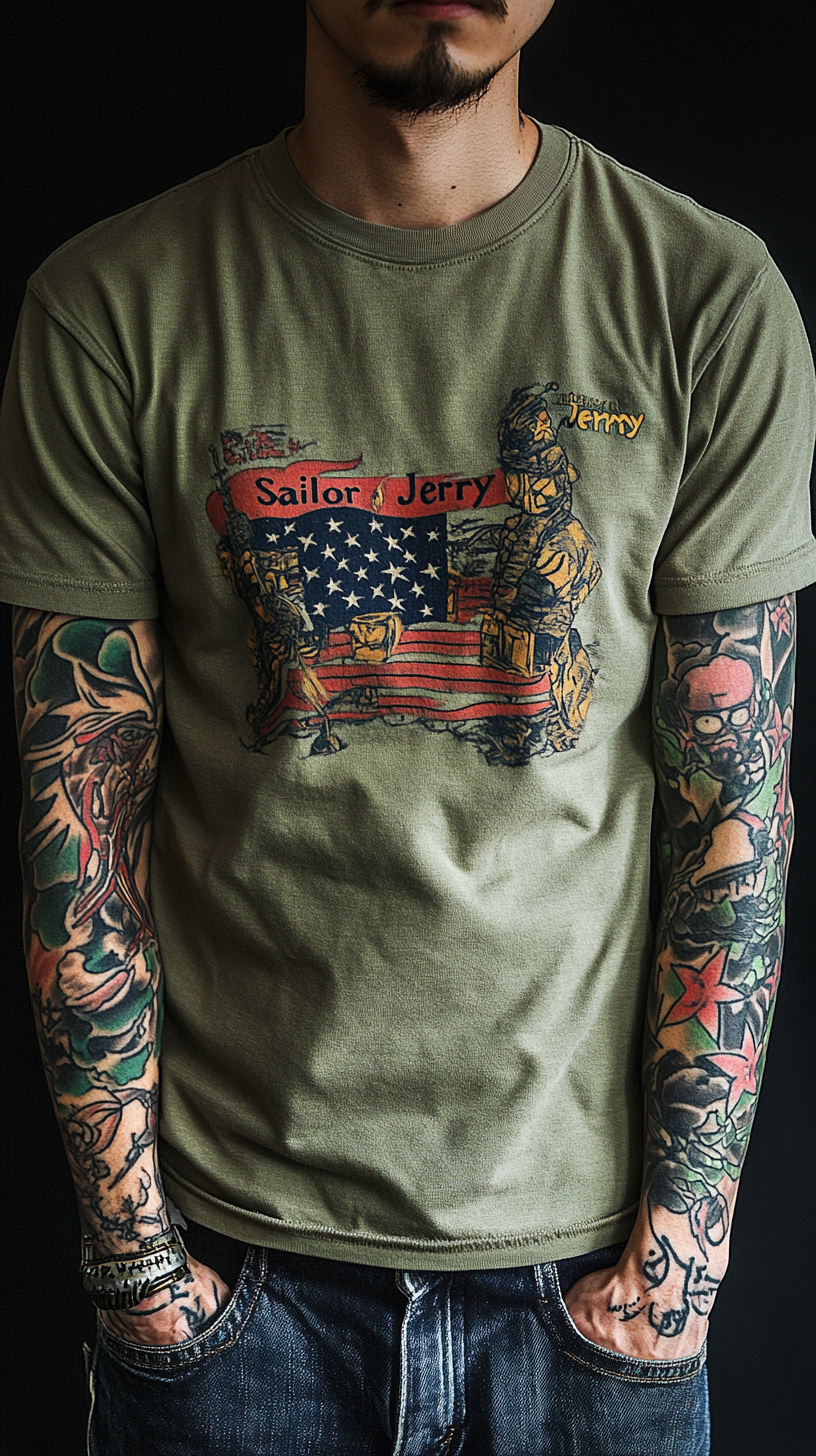
War periods dramatically influenced the development and popularity of patriotic vintage tattoos in America, creating distinct styles that remain iconic today.
- Industry War II Tattoos sparked the golden age of American traditional tattooing. The 1940s saw an explosion of patriotic imagery as millions of service members sought tattoos before deployment. Artists like Norman “Sailor Jerry” Collins refined techniques for creating bold, legible designs that would withstand time and aging skin.
- Vietnam Era Designs introduced darker, more complex patriotic imagery. Eagles began appearing with more aggressive postures, and flags were sometimes paired with memorial elements. These tattoos often expressed complicated feelings about duty and country during a controversial conflict.
- Military Branch Symbols became standardized during major wars. The anchor for Navy, eagle for Army, and globe-and-anchor for Marines all developed their distinctive traditional style during these periods. These designs featured thick outlines and simple color schemes for maximum visibility.
- “Death Before Dishonor” and similar motto tattoos emerged from wartime service values. These text-based designs typically feature bold, banner-style lettering wrapped around patriotic imagery, reflecting the code of honor embraced by military personnel.
- Memorial Tattoos evolved during wartime to honor fallen comrades. Traditional designs often featured eagles or flags with dog tags, boots, or helmets arranged in tribute formations. These solemn pieces maintain the bold Americana style while conveying deep personal meaning.
- Battlefield Tattooing during wartime created distinctive techniques. Improvised equipment and challenging conditions led to a straightforward approach that emphasized bold lines and simple compositions—characteristics that define classic Americana style to this day.
Traditional Japanese Influence on Vintage Tattoo Art
Koi Fish, Dragons, and Cherry Blossoms: Timeless Eastern Motifs
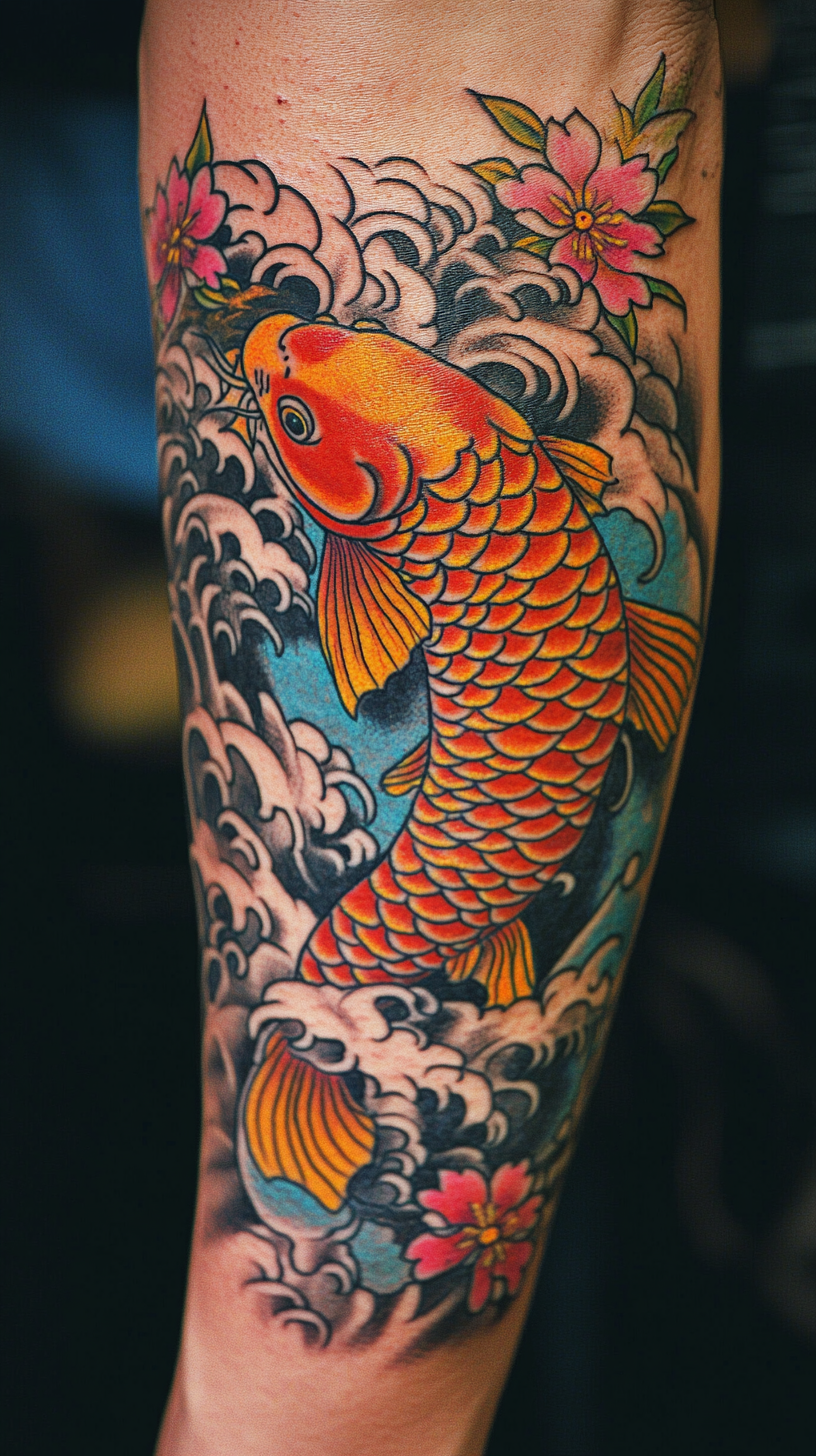
Traditional Japanese imagery has profoundly shaped vintage tattoo art, bringing a rich tapestry of symbolic motifs to Western tattooing. Koi fish designs represent perseverance and determination, drawing from the Japanese legend of koi swimming upstream to become dragons. These vibrant fish typically appear in ever-changing poses, struggling against waves or waterfalls, symbolizing triumph over adversity. Dragons in Japanese tattoo tradition symbolize wisdom, strength, and good fortune, often depicted with fearsome expressions and serpentine bodies that flow beautifully across the skin. Cherry blossoms (sakura) add an elegant touch to vintage Japanese-inspired tattoos, representing the ephemeral nature of life due to their brief blooming period. Other prominent motifs include fierce tigers symbolizing courage, protective phoenixes representing rebirth, and serene lotus flowers signifying purity emerging from murky waters.
The Art of Irezumi and Its Western Adaptation
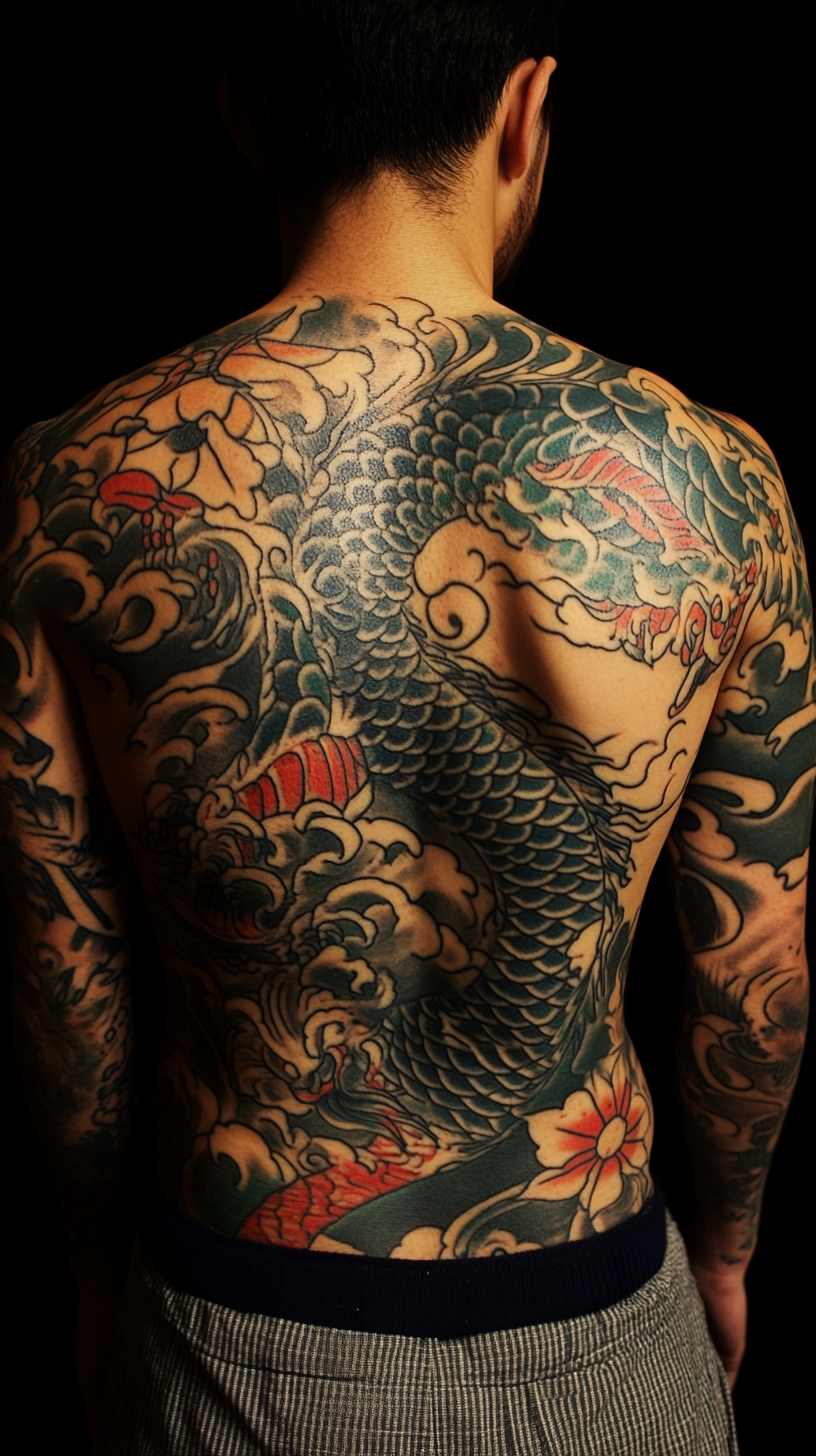
Irezumi, Japan’s traditional hand-poked tattoo technique, has significantly influenced vintage Western tattoo styles since the late 1800s. Sailors returning from East Asia brought back tales and souvenirs of elaborate full-body tattoos, inspiring American tattoo artists to incorporate Japanese elements into their flash sheets. While traditional irezumi involves painful, time-consuming hand-poking with bamboo tools, Western adaptations quickly embraced the efficiency of electric tattoo machines while maintaining Japanese aesthetic principles. Sailor Jerry Collins was among the first prominent Western artists to masterfully blend Japanese techniques with American sensibilities, creating a hybrid style featuring bold outlines, saturated colors, and Eastern symbolism within Western compositions. Modern vintage-inspired tattooists continue this tradition, respecting irezumi’s emphasis on body placement and flow while adapting designs to suit Western tastes. The Japanese influence remains evident in how vintage tattoos use negative space, create harmony between elements, and emphasize storytelling through symbolism rather than literal representation.
Circus and Carnival Imagery in Vintage Tattoo Culture
Sideshow Performers and Their Iconic Body Art
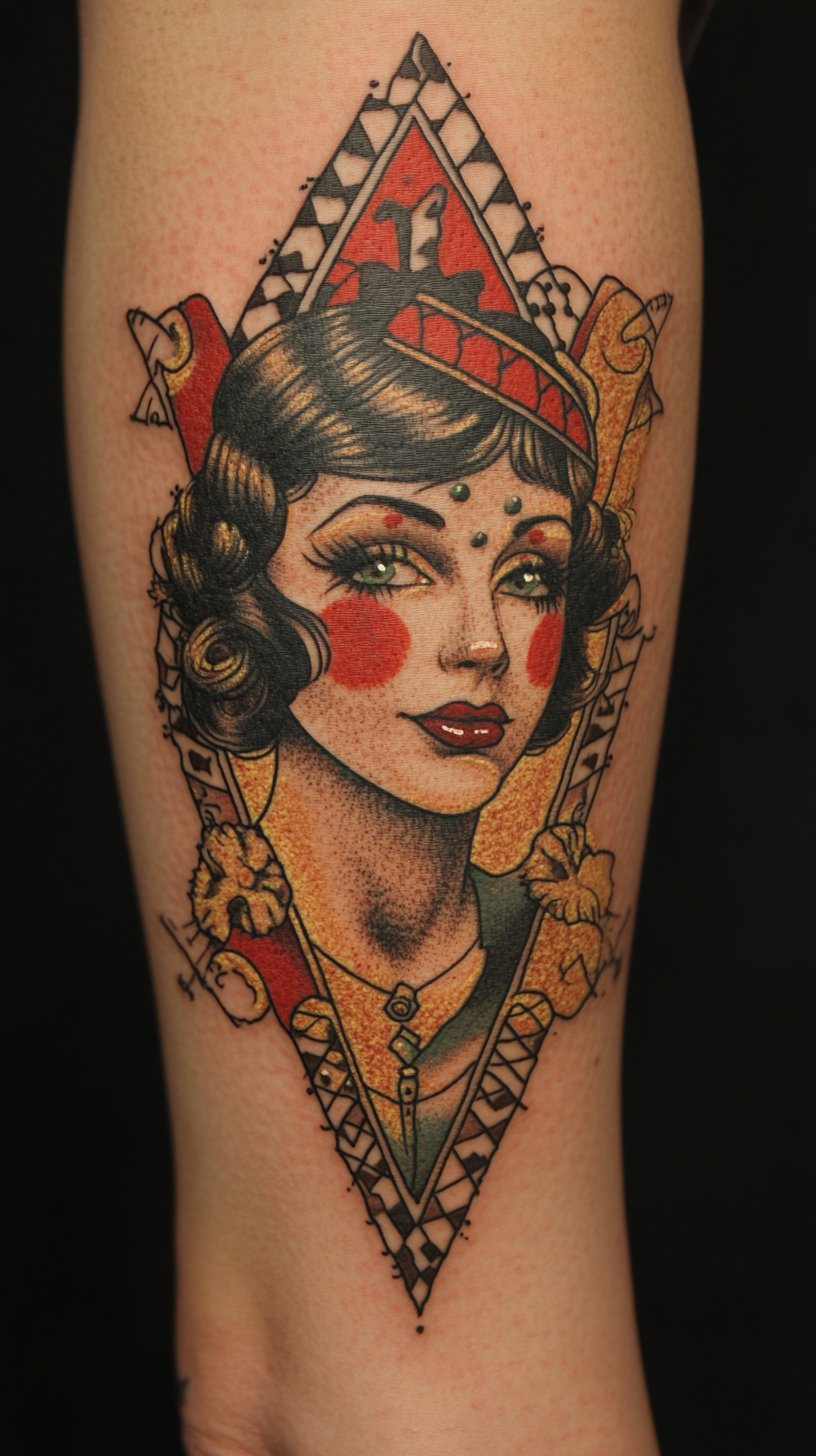
Sideshow performers played a pivotal role in popularizing tattoos during the golden age of circuses. These heavily tattooed individuals became walking canvases, displaying elaborate designs that captivated audiences nationwide. The “tattooed ladies” of the 1920s and 1930s, like Betty Broadbent and May Vandermark, earned fame and fortune by showcasing their extensively inked bodies in carnival attractions. Their bold designs frequently featured patriotic symbols, religious imagery, and intricate patterns covering large portions of their bodies.
The tattoo aesthetic from this era embraced bold outlines and simplified imagery that could be viewed from a distance by circus audiences. Sword swallowers, strongmen, and fire-eaters often sported tattoos that emphasized their performance personas, with designs specifically created to enhance their showmanship. These performers’ tattoos not only served as entertainment but also documented an important chapter in tattoo history, preserving styles that might otherwise have been lost to time.
Modern vintage-inspired sideshow tattoos typically include portraits of famous performers, carnival banners, and traditional sideshow typography. Artists specializing in this style, like Valerie Vargas and Bert Krak, carefully study archival photographs to recreate the authentic look and feel of early 20th century carnival tattoo aesthetics. These designs connect wearers to the rich, colorful industry of traveling shows and the unconventional characters who made tattoo art more visible to mainstream America.
Big Top Motifs: Lions, Elephants, and Ringmasters
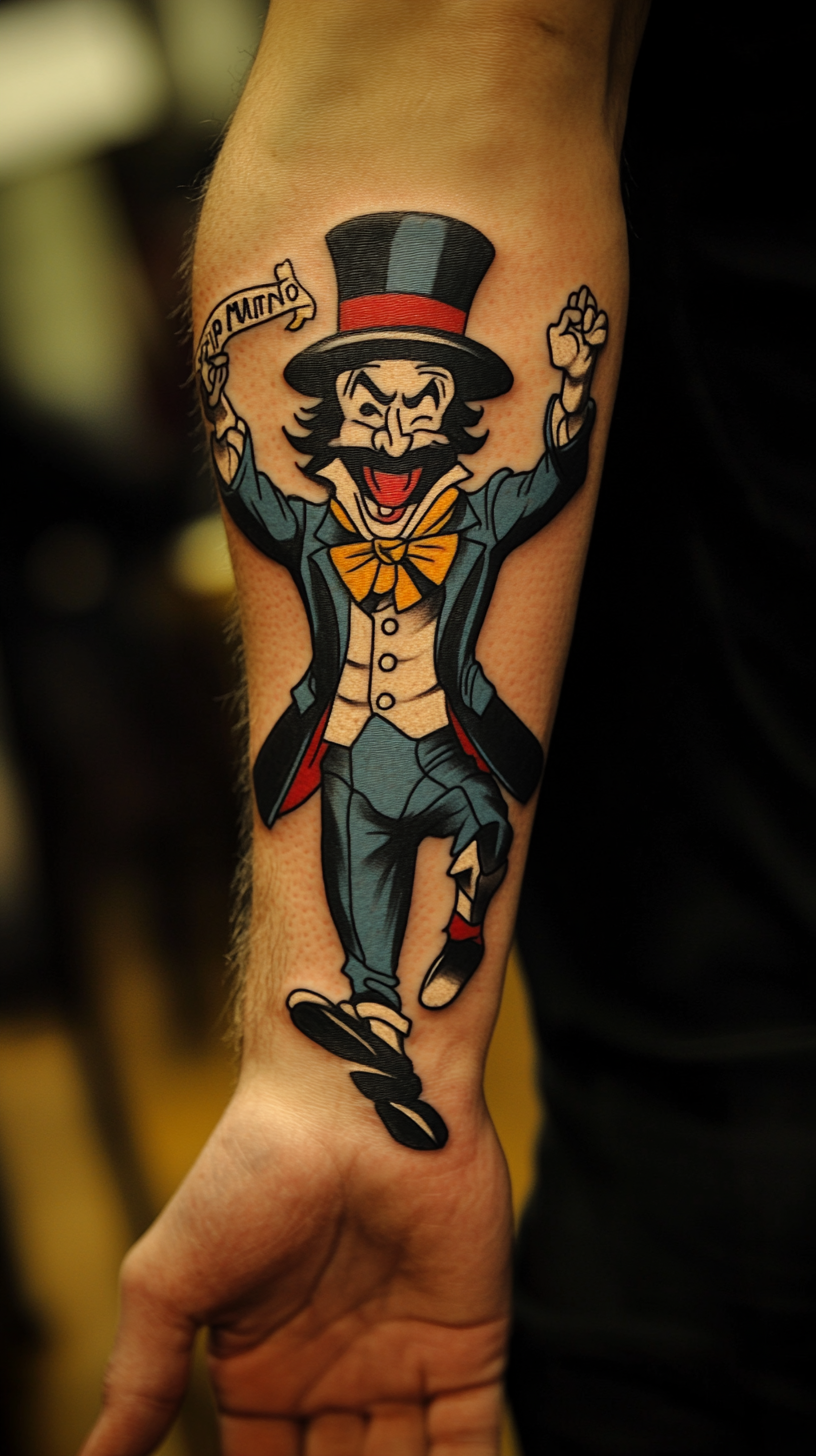
Big top circus imagery offers some of the most visually striking designs in vintage tattoo art. Lions serve as powerful symbols of courage and strength, typically depicted with majestic manes and fierce expressions in traditional vintage styles. These tattoos often feature the lion mid-roar, showcasing the animal’s power while incorporating classic American traditional elements like bold black outlines and limited color palettes. The iconic circus lion represents both the majesty of nature and humanity’s attempt to tame the untamable.
Elephant tattoos from the circus tradition symbolize wisdom, good luck, and memory, making them meaningful choices for commemorative tattoos. Vintage circus elephants are frequently illustrated performing tricks, standing on decorated platforms, or wearing ornate headdresses. The designs capture both the grandeur and the somewhat melancholy nature of these magnificent creatures in captivity. Artists like Sailor Jerry occasionally incorporated circus elephants into their flash sheets, establishing them as classic American traditional motifs.
Ringmaster tattoos represent leadership, showmanship, and the orchestration of life’s chaos. These designs typically feature sharply dressed figures with top hats, coats with tails, and commanding postures. The vintage aesthetic applies bold colors to the ringmaster’s costume, often using red, blue, and gold to create a ever-changing focal point. Some designs incorporate banners with personal mottos or circus slogans, allowing wearers to add personalized meaning to these classic images.
The color palette for circus-themed vintage tattoos tends toward bright primary colors that mirror circus advertising from the early 20th century. Red backgrounds create dramatic contrast for animal silhouettes, while yellows and blues highlight costume details. Many traditional artists use aged parchment effects and slightly faded color techniques to give new tattoos the appearance of vintage circus posters or sideshow banners. These artistic choices connect modern wearers to the rich visual history of American carnival culture while creating tattoos that maintain the bold, readable qualities essential to traditional tattooing.
Religious and Mystical Symbols in Vintage Tattoo Tradition
Sacred Hearts, Crosses, and Religious Iconography

Religious symbolism has been a cornerstone of vintage tattoo art, offering both spiritual meaning and striking visual appeal. Sacred heart tattoos emerged as one of the most iconic religious designs in traditional tattooing, typically depicted with flames, thorns, and radiating light. These hearts symbolize divine love and sacrifice, often incorporating elements like daggers or banners with personal inscriptions. The bold outlines and vibrant reds characteristic of vintage tattoo styles make sacred hearts particularly striking against the skin.
Crosses represent another fundamental religious symbol in vintage tattoo tradition, appearing in various forms from simple Latin crosses to ornate Celtic designs. Traditional tattooists frequently embellished crosses with roses, banners, or doves to create more personalized religious statements. These designs gained popularity among sailors and soldiers seeking divine protection during dangerous journeys or combat missions.
Virgin Mary tattoos stand as perhaps the most recognizable religious iconography in vintage tattoo art. Rendered in the distinctive old-school style with limited color palettes and bold outlines, these tattoos pay homage to the maternal figure of Christianity. Tattoo artists of the early 20th century developed standardized depictions of Mary that have become instantly recognizable elements of traditional tattoo flash, creating a visual language that connects wearers to generations of faithful before them.
Fortune Tellers, Tarot Cards, and Mystical Elements
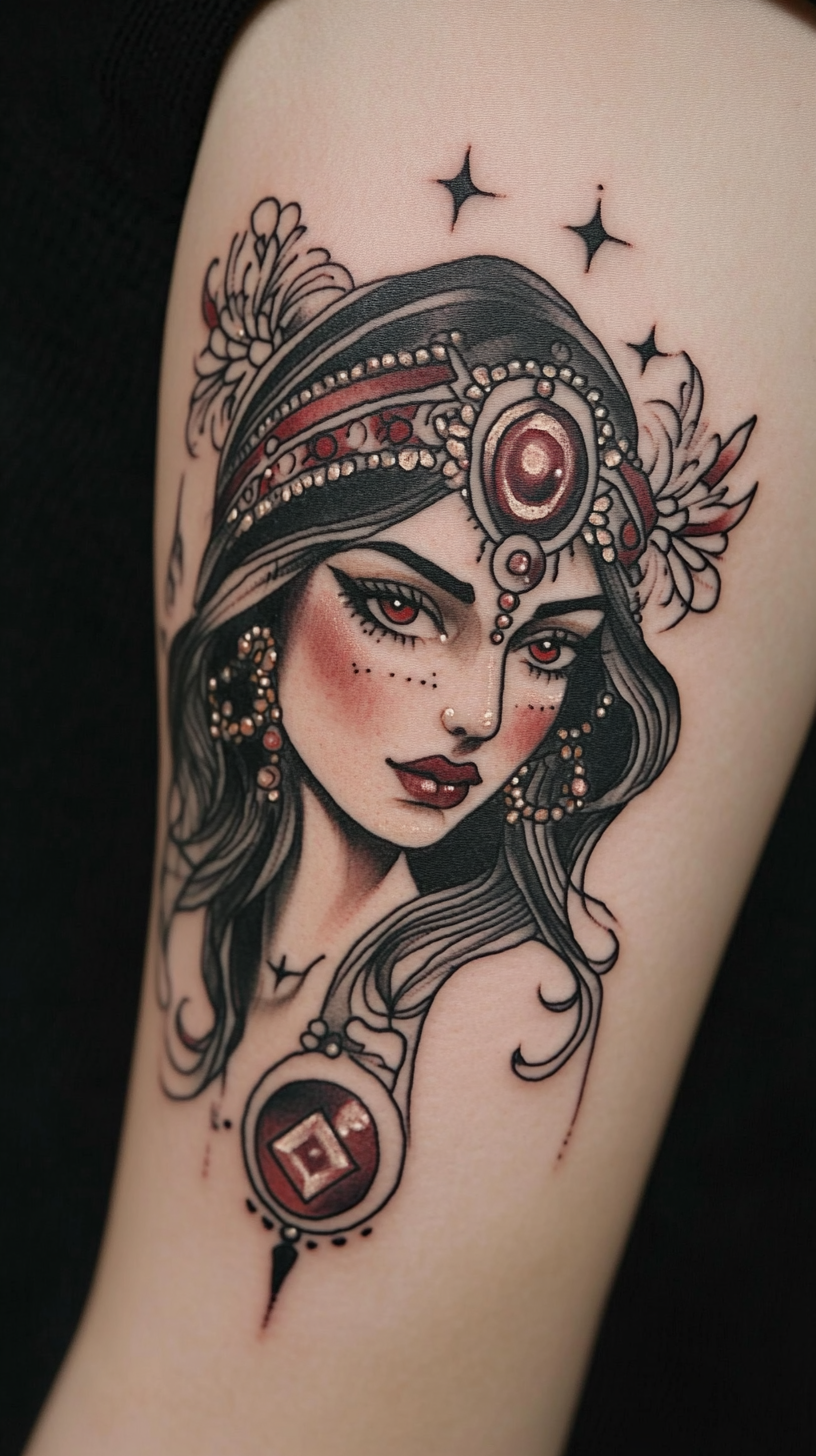
The mystical side of vintage tattoo tradition embraces symbols from divination and occult practices, offering both aesthetic appeal and deeper spiritual significance. Fortune teller imagery emerged as popular tattoo subjects during the early 20th century, coinciding with the prominence of mystics in traveling carnival shows. These designs typically feature crystal balls, mysterious women in elaborate headdresses, and cosmic elements like stars and moons. The limited color palette of traditional tattooing—usually restricted to bold primary colors—gives these mystical figures a dramatic, otherworldly quality.
Tarot card designs represent some of the most visually striking mystical tattoos in vintage tradition. Cards like “The Lovers,” “Death,” and “The Sun” translate beautifully to the skin with their symbolic imagery and clear compositions. Early tattoo artists adapted these complex symbols to fit the constraints of traditional tattooing techniques, creating simplified yet powerful versions that maintained their esoteric meanings while adhering to the bold-lined, limited-color approach of American traditional style.
The all-seeing eye, another staple of mystical vintage tattoos, appears frequently in traditional flash sheets dating back to the early 1900s. This symbol represents divine providence and spiritual awareness, often incorporated with other elements like pyramids, clouds, or rays of light. The distinctive style of vintage all-seeing eye tattoos—characterized by heavy black outlines and minimal shading—has remained remarkably consistent through decades of tattoo evolution, connecting modern wearers to a long tradition of spiritual seekers who chose to mark their bodies with symbols of higher consciousness.
Zodiac symbols have also held a special place in vintage tattoo art, offering personalized mystical imagery based on birth dates. Traditional tattooists developed simplified versions of astrological signs that worked well within the constraints of early tattoo technology, focusing on bold imagery that would remain legible throughout the wearer’s lifetime. These designs typically featured the symbol alongside stars, moons, or personalized banners, creating a cosmic connection that merges personal identity with universal mystical traditions.
How to Choose the Perfect Vintage Tattoo Design for Your Style
Working With Artists Who Specialize in Traditional Techniques
Finding the right artist is crucial when pursuing a vintage tattoo design. Look for tattooists who specifically advertise traditional or old school styles in their portfolio. These specialists have dedicated years to mastering techniques that create authentic vintage aesthetics with bold lines and solid coloring. Before booking an appointment, research artists’ Instagram accounts or websites to evaluate their experience with classic designs like anchors, roses, or pin-ups.
When consulting with potential artists, bring reference images from traditional flash sheets or historical tattoo photographs. Quality vintage tattoo artists will discuss how to adapt classic designs to suit your personal style while maintaining authenticity. They’ll explain technical aspects like line weight and traditional color palettes that make vintage tattoos distinctive.
Be prepared to invest more time and money for artists with specialized traditional skills. Experienced old school tattooists often have waiting lists of 3-6 months, but this patience ensures you’ll receive artwork that truly honors vintage tattooing traditions. During consultations, ask artists about their apprenticeship background and influences—artists trained in traditional methods will enthusiastically share their knowledge about tattoo history.
Placement Considerations for Maximum Vintage Impact
Placement dramatically affects how vintage tattoos are viewed and interpreted. Classic designs were traditionally placed on exact body parts for maximum visibility and impact. Forearms, upper arms, and chest panels remain prime locations for vintage tattoos, allowing designs to be displayed with the bold presence they deserve. These traditional placements also ensure proper scaling—a Sailor Jerry eagle needs adequate space to showcase its detailed wingspan and bold outlines.
Consider movement and body contours when placing vintage designs. Nautical tattoos like ships and anchors traditionally follow muscle lines on forearms or biceps, improving their visual flow. Pin-up girls classically adorn the upper arm or thigh, where the curved surface complements their feminine forms. Religious imagery like sacred hearts and crosses is traditionally centered on the chest or back for symmetry and significance.
Size matters significantly with vintage tattoos—these designs weren’t meant to be tiny. Traditional pieces require sufficient space for thick outlines and simple shading techniques to read properly. While small anchor tattoos behind ears or on wrists have become popular, authentic vintage tattoos typically start at 3-4 inches minimum to maintain their characteristic boldness and longevity. Discuss with your artist how traditional sizing principles can be adapted to your comfort level while preserving the essential vintage aesthetic.
Modern Revival: Why Vintage Tattoos Are Making a Comeback
Social Media Influence
Social media platforms have dramatically accelerated the vintage tattoo revival. Instagram accounts dedicated to traditional tattoo art regularly attract millions of followers, with hashtags like #traditionaltattoo and #oldschooltattoo generating billions of views. Artists who specialize in vintage styles have built substantial online followings, showcasing their work to audiences that might never have discovered traditional tattooing otherwise. Platforms like Pinterest have become digital mood boards for tattoo enthusiasts, with vintage flash sheets being among the most saved tattoo content. This digital exposure has introduced a new generation to the bold lines and vivid colors of classic tattoo designs.
Celebrity Endorsements
Celebrities have played a important role in popularizing vintage tattoos. Stars like Rihanna, Harry Styles, and Miley Cyrus proudly display traditional tattoo art, influencing their millions of fans. Post Malone’s collection of vintage-inspired facial tattoos has normalized bold placement choices. Adam Levine’s extensive collection of traditional American tattoos showcases how vintage designs can create a cohesive body narrative. These high-profile endorsements have repositioned vintage tattoos from counterculture symbols to mainstream fashion statements. When celebrities choose traditional designs over trendy minimalist options, it signals the enduring value of vintage tattoo artistry.
Reaction Against Minimalism
The vintage tattoo resurgence represents a direct response to the minimalist tattoo trend that dominated the 2010s. After years of tiny line work, geometric shapes, and watercolor techniques, many tattoo enthusiasts are rediscovering the bold impact of traditional designs. Vintage tattoos offer guaranteed longevity that fine-line work simply can’t match. Their thick outlines and solid colors are specifically designed to age well, maintaining definition and vibrancy for decades. This practical advantage has driven many first-time tattoo clients toward traditional styles, seeing them as a worthwhile investment rather than a temporary fashion statement.
Authenticity in the Digital Age
In our increasingly digital industry, vintage tattoos offer tangible connections to history and craftsmanship. Traditional tattoo designs carry narratives that have evolved over generations, giving wearers a sense of participating in a living tradition. The deliberate imperfections and hand-crafted quality of vintage tattoos stand in contrast to the digital precision that dominates contemporary aesthetics. Young adults particularly value this authenticity, seeing traditional tattoos as an antidote to the filtered perfection of online life. The permanence of vintage tattoos also provides a counterbalance to the ephemeral nature of digital content.
Feminist Reclamation
Women have been instrumental in the revival of vintage tattoo aesthetics, reclaiming and reinterpreting traditionally masculine imagery. Female tattoo artists specializing in American Traditional styles have grown their clientele by 300% since 2015, according to industry surveys. Traditional designs like daggers, panthers, and eagles are being reimagined through a female lens, challenging gender norms while honoring tattoo history. Pin-up girl designs have been particularly transformed, with modern artists creating more diverse and empowering representations. This feminist reclamation has expanded the appeal of vintage tattoos to women who might previously have found traditional designs unwelcoming.
Craftsmanship Appreciation
The technical skill required for successful vintage tattoos has fueled their comeback. Traditional tattooing demands precision, consistency, and deep understanding of how ink behaves in skin over time. The renaissance of apprenticeship-based learning in tattoo shops has produced a new generation of artists deeply versed in traditional techniques. Clients increasingly research artists’ technical abilities before committing to tattoos, recognizing that traditional work requires specialized expertise. This emphasis on craftsmanship has elevated vintage tattoos from mere fashion to respected art form, attracting collectors who value technical excellence.
Pandemic Reflection
The COVID-19 pandemic sparked important growth in vintage tattoo popularity. During lockdowns, many people had time to research tattoo history and develop appreciation for traditional designs. Post-lockdown statistics show a 45% increase in requests for American Traditional tattoos, according to a 2022 industry report. Many clients emerged from isolation seeking meaningful, substantial body art rather than trendy designs. Traditional imagery like swallows (representing freedom) and lighthouses (symbolizing guidance) took on new resonance after the shared experience of confinement. The pandemic reminded many that life is unpredictable, driving them toward tattoos with proven staying power.
Heritage Connection
Vintage tattoo styles offer powerful connections to cultural and family heritage. Military-inspired tattoos honor relatives who served, while traditional roses and eagles connect wearers to American visual history. Immigrant communities have embraced traditional tattooing as a way to connect with their adopted homeland while maintaining ties to their origins. Japanese-American traditional fusion styles particularly exemplify this bridging of cultural identities. For many second and third-generation Americans, choosing vintage tattoo designs represents a conscious engagement with their complex heritage, honoring family sacrifices while embracing American traditions.
Frequently Asked Questions
What makes vintage tattoos so popular?
Vintage tattoos remain popular because of their timeless appeal, bold artistry, and rich symbolism. These designs—like anchors, roses, and eagles—connect wearers to a long lineage of tattoo enthusiasts spanning centuries. They carry historical significance while maintaining visual impact, making them meaningful choices for both first-time tattoo seekers and experienced collectors. Their enduring popularity stems from their ability to tell stories through established imagery that has withstood the test of time.
How old is the tradition of vintage tattoos?
The tradition of vintage tattoos dates back over 5,000 years. Evidence appears on ancient Egyptian mummies and in Polynesian tribal cultures. Western vintage tattoo styles gained prominence when 18th and 19th-century sailors adopted tattooing from indigenous cultures during their travels. These designs evolved through military conflicts, carnival culture, and the counterculture movements of the mid-20th century, creating the rich visual language we recognize as vintage tattoo art today.
What do nautical tattoos symbolize?
Nautical tattoos carry specific meanings within sailor culture. Anchors represent stability and safe returns home. Ships symbolize adventure and the sailor’s livelihood. Swallows indicate a sailor’s experience (traditionally one for every 5,000 nautical miles traveled). Nautical stars served as practical navigational symbols, while rope designs showcased a sailor’s skills. These tattoos functioned as both personal talismans and visual records of a sailor’s journeys and accomplishments.
Why are pin-up girl tattoos significant in vintage tattoo culture?
Pin-up girl tattoos celebrate feminine beauty and became iconic in mid-20th century America. Influenced by artists Alberto Vargas and Gil Elvgren, these designs blend nostalgia, sensuality, and Americana. They represented comfort and connection for service members during wartime. Modern interpretations maintain classic aesthetics while embracing diversity and personalization. Despite changing social attitudes, pin-up tattoos remain among the most requested vintage designs, demonstrating their timeless appeal across generations.
What patriotic symbols are common in vintage American tattoos?
Common patriotic symbols in vintage American tattoos include eagles (representing freedom), American flags, Lady Liberty, and military insignias. These designs gained popularity during major conflicts, particularly World War II, which sparked a golden age of patriotic imagery. They often incorporate red, white, and blue color schemes with bold outlines. Veterans frequently chose these tattoos to express national pride, commemorate service, and honor fallen comrades.
How has Japanese art influenced vintage tattoo styles?
Japanese art has profoundly influenced vintage tattoo styles since the late 1800s. Traditional motifs like koi fish (symbolizing perseverance), dragons (representing wisdom and strength), and cherry blossoms (signifying life’s impermanence) became staples in Western tattooing. The compositional techniques of irezumi—Japan’s traditional tattooing practice—inspired American artists like Sailor Jerry Collins, who incorporated Japanese elements into their work. This influence is evident in the use of negative space and storytelling through symbolism in vintage designs.
What role did circus and carnival culture play in vintage tattoo history?
Circus and carnival culture significantly popularized tattoos in America. During the golden age of circuses (late 1800s to early 1900s), tattooed performers became attractions themselves, particularly “tattooed ladies” who challenged Victorian norms. These sideshow performers showcased elaborate designs that fascinated audiences. The aesthetic featured bold outlines and simplified imagery that could be viewed from a distance. This cultural crossover established many circus-themed designs—lions, elephants, ringmasters—as classics in vintage tattoo imagery.
What religious and mystical symbols appear in traditional tattoos?
Traditional tattoos frequently feature religious symbols like sacred hearts (representing divine love), crosses (often personalized with roses or banners), and Virgin Mary imagery (connecting wearers to faith traditions). Mystical elements include fortune teller imagery, tarot cards (particularly “The Lovers” and “Death” cards), and zodiac symbols. These designs maintain a bold, simplified style characteristic of vintage tattoos while offering both aesthetic appeal and spiritual significance to wearers.
How do I choose a tattoo artist for a vintage-style design?
Choose an artist who specializes in traditional techniques by researching portfolios specifically for vintage work. Look for clean, bold lines, solid color saturation, and proper understanding of traditional iconography. Visit shops that display flash sheets of classic designs. Bring reference images to consultations and be prepared to invest time and money—quality traditional work isn’t cheap. Experienced artists may suggest placement and sizing modifications to ensure your design ages well while maintaining vintage authenticity.
Why are vintage tattoos experiencing a modern revival?
Vintage tattoos are experiencing a revival due to several factors: social media has introduced traditional designs to new audiences; celebrities have normalized vintage tattoos as fashion statements; and there’s growing appreciation for authenticity and craftsmanship in an increasingly digital world. Additionally, female artists have reclaimed and diversified traditional imagery, expanding its appeal. The COVID-19 pandemic further fueled interest as people sought meaningful, substantial art during uncertain times. Many also choose vintage styles to connect with cultural or family heritage.

